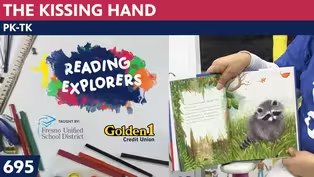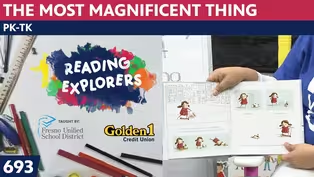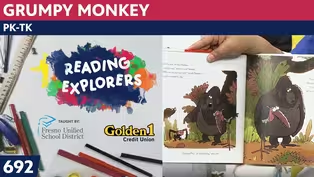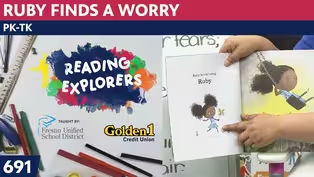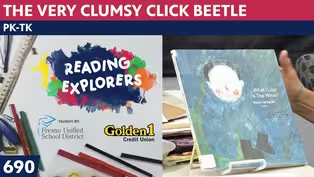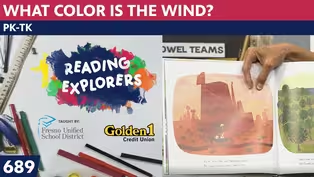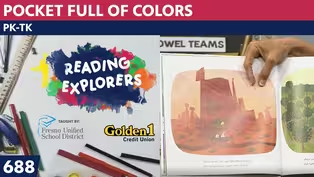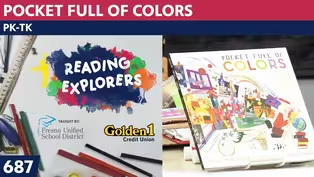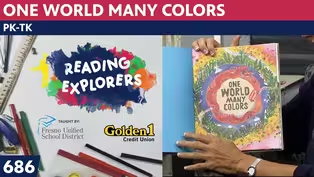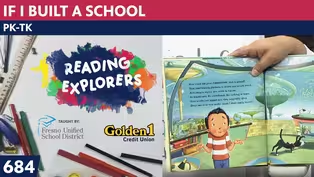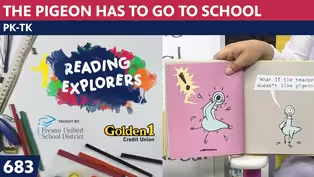
TK-367: Paint A Water Lily Pond in Monet style
Season 3 Episode 373 | 14m 12sVideo has Closed Captions
Join me today as we continue our Monet Water Lilies study.
Join me today as we continue our Monet Water Lilies study. Each day this week we will introduce a Monet masterpiece or a water lily themed painting. Today we will learn to paint a small lily pond in the short brush stroke style (tache/touch) of Claude Monet. His water was made with rectangle strokes with vertical reflections of trees/bushes on the water. If you would like to paint a water lily p
Problems playing video? | Closed Captioning Feedback
Problems playing video? | Closed Captioning Feedback
Reading Explorers is a local public television program presented by Valley PBS

TK-367: Paint A Water Lily Pond in Monet style
Season 3 Episode 373 | 14m 12sVideo has Closed Captions
Join me today as we continue our Monet Water Lilies study. Each day this week we will introduce a Monet masterpiece or a water lily themed painting. Today we will learn to paint a small lily pond in the short brush stroke style (tache/touch) of Claude Monet. His water was made with rectangle strokes with vertical reflections of trees/bushes on the water. If you would like to paint a water lily p
Problems playing video? | Closed Captioning Feedback
How to Watch Reading Explorers
Reading Explorers is available to stream on pbs.org and the free PBS App, available on iPhone, Apple TV, Android TV, Android smartphones, Amazon Fire TV, Amazon Fire Tablet, Roku, Samsung Smart TV, and Vizio.
Providing Support for PBS.org
Learn Moreabout PBS online sponsorshipMore from This Collection
Valley PBS and Fresno Unified School District have partnered with Golden 1 Credit Union to create Reading Explorers Lessons for grades Pre-Kindergarten through Third grade. The daily lessons will be taught by Fresno Unified School District teachers and are created to help students practice their reading skills and reinforce lessons during distance learning.
Video has Closed Captions
Valley PBS presents Reading Explorers Lessons for Pre-Kindergarten and TK. (26m 27s)
PK-TK-693-The Most Magnificent Thing
Video has Closed Captions
Valley PBS presents Reading Explorers Lessons for Pre-Kindergarten and TK. (26m 26s)
Video has Closed Captions
Valley PBS presents Reading Explorers Lessons for Pre-Kindergarten and TK. (26m 28s)
Video has Closed Captions
Valley PBS presents Reading Explorers Lessons for Pre-Kindergarten and TK. (26m 28s)
PK-TK-690: The Very Clumsy Click Beetle
Video has Closed Captions
Valley PBS presents Reading Explorers Lessons for Pre-Kindergarten and TK. (26m 22s)
PK-TK-689: What Color is the Wind?
Video has Closed Captions
Valley PBS presents Reading Explorers Lessons for Pre-Kindergarten and TK. (26m 21s)
PK-TK-688: Pocket Full of Colors
Video has Closed Captions
Valley PBS presents Reading Explorers Lessons for Pre-Kindergarten and TK. (25m 58s)
PK-TK-687: Dancing Through Fields of Colors
Video has Closed Captions
Valley PBS presents Reading Explorers Lessons for Pre-Kindergarten and TK. (26m 20s)
PK-TK-686: One World Many Colors
Video has Closed Captions
Valley PBS presents Reading Explorers Lessons for Pre-Kindergarten and TK. (27m 13s)
PK-TK-685: School is Wherever I am
Video has Closed Captions
Valley PBS presents Reading Explorers Lessons for Pre-Kindergarten and TK. (26m 32s)
PK-TK-684: If I Built a School
Video has Closed Captions
Valley PBS presents Reading Explorers Lessons for Pre-Kindergarten and TK. (26m 21s)
PK-TK-683: The Pigeon Has to Go to School
Video has Closed Captions
Valley PBS presents Reading Explorers Lessons for Pre-Kindergarten and TK. (26m 22s)
Providing Support for PBS.org
Learn Moreabout PBS online sponsorship♪ Good morning to a brand new day ♪ ♪ Time to learn and games to play ♪ ♪ Learning things is so much fun ♪ ♪ Learning is good for everyone ♪ (playful music) - Hello, early learners.
And welcome back to the art room.
Let's start our day with our hello song.
♪ Hello, nice to see you, everyone ♪ ♪ Hello, nice to see you, everyone ♪ ♪ Hello to you, hello to you ♪ ♪ Hello to you, hello to me ♪ ♪ Hello, nice to see you, everyone ♪ Alrighty, yesterday, we found out that we're learning all about Claude Monet and his water lily pond pictures.
It's just called water lilies.
Now, it's a series of 250 paintings of his water lily pond.
250 paint paintings of the same place.
But as I show you today, you'll notice none of them are really the same because he would do it during different times of the day.
And during different times of the day, the light reflects differently.
You'll notice if you go in your own backyard, sometimes you have shade in places that are not shady later or maybe you think that your grass looks kind of brownish when it was green in the morning.
It just depends how the light hits on things and reflects back to your eyes.
So today we're going to be doing an entire painting in one sitting.
We're not gonna use our painted paper today.
We'll start tomorrow with the blue painted one.
So if you didn't paint your papers with blue paint like maybe like these, then do it tonight and have it dry for tomorrow because tomorrow we'll add lily pads to it.
So just get your paper ready.
And remember if you don't have it, you can just color your paper with little strokes to make it with a crayon.
It will be fine.
Alrighty, let's look at Claude Monet and what he looked like as a grownup man.
And he could be seen around town with his big beard and people were interested in seeing him because he was very famous for his giant garden.
And people would go there because not only was the pond there, but there were flowers that were so beautiful besides the one on the pond all around.
You can see his garden if you go online and ask to see Monet's garden and pond, it will show you all of it.
Let's look at the one that we're going to kind of do today.
And I told you yesterday that he didn't paint trees in his paintings, he painted the reflection as if the pond was a mirror and all the trees would come down and put their color on the water.
So here, it's blue water and the trees that were above came down and were here and here and here, and there are pieces of it all along here.
But then here are the lily pads and here are the lilies.
Some of them are white with yellow.
Some are pink with yellow.
These are in the garden where you can see these are mostly the magenta and yellow centers.
And down here, there are some white ones with magenta.
And what we're going to do today is paint the lilies with white with a little bit of red on it.
So I hope you have paints with you but if you don't, please use your crayons, and you can do this project right along with me by using crayons or chalk pastels or oil pastels.
It's just, for me, today, I'm using the tempera paint.
Now, one place you can buy tempera paint if you don't have it yet is at that store where everything's a dollar.
They'll give you like six colors and it's only a dollar.
I don't know if they're really solid colors that will stay but we'll see what happens then.
I'm going to pick my table up with my paper to get ready to start painting on this piece of paper that we're going to complete the painting in one sitting.
Let me put my colors on my table as well.
And the few brushes that I'm going to use.
Now, it was kind of interesting about Monet and all the artists at that time, they did not have paints in tubes or paints in jars.
And if the artist wanted to work on an art outside, 'cause remember I told you they all did their work inside their studio, never getting any fresh air.
But then when they started painting things outside, something happened, someone figured out how to put paint into tubes and they would squeeze it out on their palette.
And I bought a little palette at the art store so that I could just do this and have it on my thumb.
So I could just paint, paint, paint.
But I'm not using it today 'cause I still have my paint from yesterday, and you know how I don't like to waste things.
But this is a place, if I had a paint in here, I could mix it into these little pans up here.
But his palette, he would take out and put all the colors, never clean it off.
You just keep it on there because, oh, there's a color you might use yesterday and want to use today.
So let me set my palette over because I just thought about the song that we were singing about Monet and I'm just going to sing it to you 'cause I don't need the words for you to see them.
I'll just sing it.
It goes.
♪ Down by the pond where the waterlily stand ♪ ♪ I saw a Monet with the paint brush in his hand ♪ ♪ His palette had its green, its yellow and blue ♪ ♪ To paint the waterlilies red ♪ ♪ And white were on there too ♪ So Monet had his brush and his palette.
Now, being outside and doing the work was great.
The other odd thing they did not have at that time were flat head brushes.
This silver part that goes around it on the round brushes is round and that's what they had, round brushes.
That's all, round headed brushes.
And if you wanted to cut the end off, it still wouldn't work the same as this way.
This way they crimp or smash the metal down to hold the bristles.
So it's thin and it is flat.
And that's the brush that Monet uses because he does those little bricks of painting, bricks of painting.
But remember this, this was the brush I showed you yesterday too.
It's made out of a sponge.
It's glued onto this wooden handle and it makes a flat end too.
And that's kind of nice to use.
And since we only have a little bit of time together, it's wider than any of my brushes.
So I thought I would use it to get started with the water.
Now, when we do this, I have white, red, yellow, blue, dark blue, and light blue, and a little bit of brown.
So I'm going to start out by doing just what we did yesterday with the blue paint.
And I'm going to paint all over it because as we do this, it is going to have a mixture of water.
And afterwards, I'm going to do the vertical part.
I told you the vertical is up and down.
Horizontal is side to side.
So the water is all done with side to side little bricks of color, just like I'm doing now, little bricks of color.
And I'm doing kind of dark close to the edge here.
And I'm going to do some light.
And you will see as I go up, I'm going to add a little lighter as I go up.
You can have your light color in the foreground, you decide, but notice I'm still doing it like Monet, little brush strokes of little bricks of color.
And when I finish the water part, I'm going to go in with my vertical strokes to put the reflection of the trees and weeping willows on here.
And then I'm going to do a few lily pads and add the lilies.
So I have to keep some of my white paint clean so I don't get all of it in with blue so that when we go to do our water lilies, I have some clean white paint to do the lily itself.
And I'll put a little edge of red in there.
Still getting my bricks of blue color.
Now, you know, if you don't have paint, you'll just put the side of your crayon and just rub, rub, rub, rub, rub, rub, rub, rub, rub, rub, like you're shading something like we've done in the past when we've done shading on fruit or we've done some shading on the edges of things to give it a form rather than a shape.
Because we know a circle is just a shape but when you add the shading, it gives it a form and makes it a three-dimensional looking shape.
So I almost got my water done, getting it in here, trying to get this going.
Even if I don't put it all on there, you know how artists will come back in and add more.
I could add more tomorrow, even though I told you this painting was supposed to be done in one sitting.
So I am going to add a little green and you notice I don't have green.
I have to make my green by adding blue and yellow together.
So now I'm going to just put in my vertical strokes of my trees reflecting on here, a little yellow, a little blue.
And putting up all of this in here.
I might add a little more yellow to that one so that it looks like it's more of the weeping willow one, and put it down here.
It's reflecting on my water, doing my vertical strokes down because we did the horizontal for the water.
Now, I'm going to add darker blue to my yellow and make it a darker color so I can make my lily pads.
And I'm going to mix that up.
A little more yellow because that blue was really dark.
And I'm going to do little lily pad, lily pad.
I think I'll use my brush, this one, with my flat head brush.
Lily pad, lily pad, lily pad.
Lily pad, lily pad, lily pad.
Put my lily pads around.
So you can tell it's the reflection of the trees and not trees in the water.
It's just the reflection.
'Cause I'm putting the lily pad on top.
I'm doing all of these kinds of circle forms.
Even though a lily pad does have a little bit of a space, it's like, oh, I don't even know how to explain it.
I'll maybe have to show you a picture tomorrow of a lily pad.
Now, this brush is all green.
I'm going to set it up aside because in this you do not want to get too much water on here 'cause then your colors don't remain good.
I'm going to add my water lily.
And what I'm doing is touching five times, two, three, four, five.
There's one lily.
One, two, three, four, five.
Let me tip it up so you can see.
I can even do it upside down.
I'm putting lilies in the middle of these pads.
Count one, two, three, four, five.
I'm gonna put a little bit of my red in there to make this lily have a little red in the middle of it.
So I put just the edge of my paintbrush in the red.
And now you can, it's probably too far away for you to see, but on your own, when you go to do it, you'll see that if you go one, two, three, four, five, your lily petals will show up.
I'm just touching.
It's like printmaking even.
I'm gonna put a little more red on this one.
I'll put it in the middle.
And we know on all the ones that we've seen in the past, the center has little yellow on it too.
Boys and girls, tomorrow, you're going to be bringing one of your blue painted papers, or if you just have blue paper and we're going to add waterlilies to them, the lily pads themselves, cutting and pasting.
So you'll need some glue, you'll need some scissors and our colors to make the lily pads.
We'll be doing that tomorrow.
And you can finish this up as you end your day because you can paint when I'm not sitting here with you.
One, two, three, four, five.
All right, boys and girls, I've been pretty happy with this.
You know, I will go back to painting more water when we're not together 'cause I didn't finish it.
But I did wanna say that I wanted to sing goodbye to you.
So boys and girls.
♪ Goodbye, see you next time, everyone ♪ ♪ Goodbye, see you next time, everyone ♪ ♪ Goodbye to you, goodbye to you ♪ ♪ Goodbye to you, goodbye to me ♪ ♪ Goodbye, see you next time, everyone ♪ You can see, I even use some of this blue mixed in with the other colors to add more to my pond, just trying to stay out of some of the colors.
I'm gonna continue painting as I wave goodbye to everyone, try and juggle everything at once.
Bye, boys and girls.
(uplifting guitar music) ♪ Good morning to brand new day ♪ ♪ Time to learn and games to play ♪ ♪ Learning things is so much fun ♪ ♪ Learning is good for everyone ♪ (uplifting guitar music)
Support for PBS provided by:
Reading Explorers is a local public television program presented by Valley PBS
